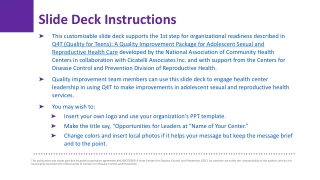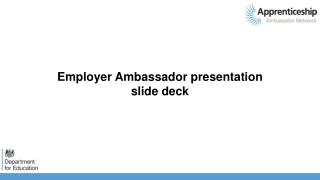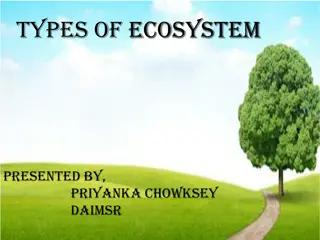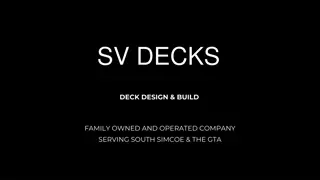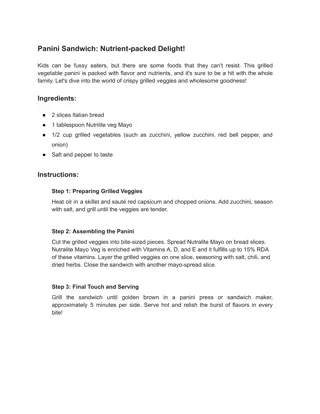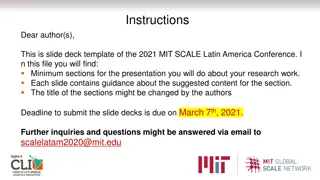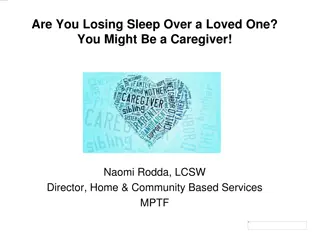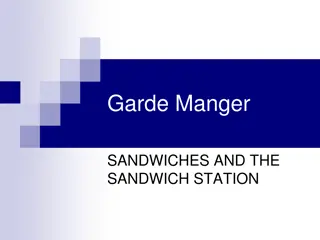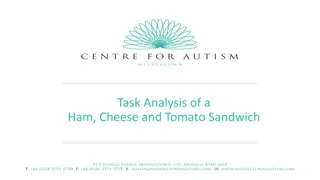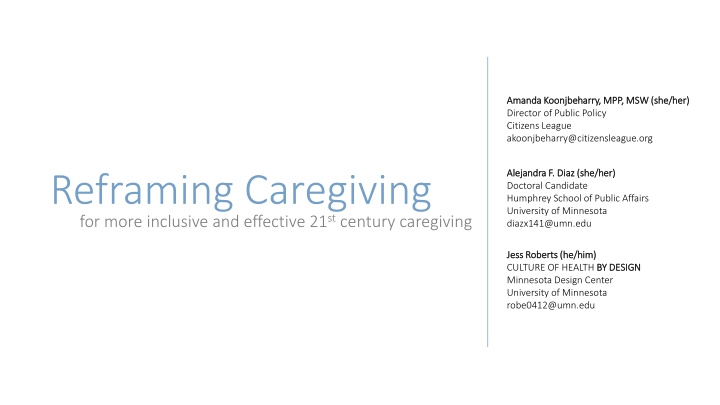
Innovative Approach to Problem-Solving Through Radical Collaboration
Explore the power of radical collaboration, humility, and rapid prototyping in navigating the unknown and addressing complex issues through iterative learning and inclusive decision-making. Learn how diverse perspectives and citizen-focused design can drive creativity and effectiveness in problem-solving efforts.
Uploaded on | 0 Views
Download Presentation

Please find below an Image/Link to download the presentation.
The content on the website is provided AS IS for your information and personal use only. It may not be sold, licensed, or shared on other websites without obtaining consent from the author. If you encounter any issues during the download, it is possible that the publisher has removed the file from their server.
You are allowed to download the files provided on this website for personal or commercial use, subject to the condition that they are used lawfully. All files are the property of their respective owners.
The content on the website is provided AS IS for your information and personal use only. It may not be sold, licensed, or shared on other websites without obtaining consent from the author.
E N D
Presentation Transcript
Amanda Amanda Koonjbeharry Koonjbeharry, MPP, MSW (she/her) Director of Public Policy Citizens League akoonjbeharry@citizensleague.org , MPP, MSW (she/her) Alejandra F. Diaz (she/her) Alejandra F. Diaz (she/her) Doctoral Candidate Humphrey School of Public Affairs University of Minnesota diazx141@umn.edu Reframing Caregiving for more inclusive and effective 21st century caregiving Jess Roberts (he/him) Jess Roberts (he/him) CULTURE OF HEALTH BY DESIGN Minnesota Design Center University of Minnesota robe0412@umn.edu BY DESIGN
1 2 3 HUMILITY HUMILITY RADICAL COLLABORATION RADICAL COLLABORATION RAPID PROTOTYPING RAPID PROTOTYPING The only safe way to navigate the unknown is to iteratively learn your way forward in small steps. Rather than fully deploying a few theory-only ideas, testing many rough assumptions and ideas in rapid iteration, or prototyping, aims to generate and test multiple alternative hypotheses, assumptions and divergent strategies before selecting the best available option(s) for further refinement. Top-down approaches tend to exclude those most impacted and with the most at stake in addressing problems from the design and decision-making process. In contrast, a citizen- design model formalizes opportunities for shared power and decision-making. This is especially important when working with marginalized communities where important relationships, institutions, systems, culture and history can be invisible to even the most thoughtful decision-makers. Collaboration is nothing new. Yet too often it involves the same people addressing the same problems in the same ways and expecting different outcomes. Radical collaboration suggests that diversity of ideas, experiences, cultures and socio- economic backgrounds is not only a good idea, it is fundamental to new ways of understanding and addressing old problems (creativity). ADAPTED FROM: Jess P. Roberts, Thomas R. Fisher, Matthew J. Trowbridge, Christine Bent Jess P. Roberts, Thomas R. Fisher, Matthew J. Trowbridge, Christine Bent, A design thinking framework for healthcare management and innovation, Healthcare, Volume 4, Issue 1, March 2016, Pages 11-14 h
1 2 3 HUMILITY HUMILITY RADICAL COLLABORATION RADICAL COLLABORATION RAPID PROTOTYPING RAPID PROTOTYPING The only safe way to navigate the unknown is to iteratively learn your way forward in small steps. Rather than fully deploying a few theory-only ideas, testing many rough assumptions and ideas in rapid iteration, or prototyping, aims to generate and test multiple alternative hypotheses, assumptions and divergent strategies before selecting the best available option(s) for further refinement. Top-down approaches tend to exclude those most impacted and with the most at stake in addressing problems from the design and decision-making process. In contrast, a citizen- design model formalizes opportunities for shared power and decision-making. This is especially important when working with marginalized communities where important relationships, institutions, systems, culture and history can be invisible to even the most thoughtful decision-makers. Collaboration is nothing new. Yet too often it involves the same people addressing the same problems in the same ways and expecting different outcomes. Radical collaboration suggests that diversity of ideas, experiences, cultures and socio- economic backgrounds is not only a good idea, it is fundamental to new ways of understanding and addressing old problems (creativity). ADAPTED FROM: Jess P. Roberts, Thomas R. Fisher, Matthew J. Trowbridge, Christine Bent Jess P. Roberts, Thomas R. Fisher, Matthew J. Trowbridge, Christine Bent, A design thinking framework for healthcare management and innovation, Healthcare, Volume 4, Issue 1, March 2016, Pages 11-14 h
CO CO- -DESIGN STRUCTURE DESIGN STRUCTURE CULTURE OF HEALTH BY DESIGN BY DESIGN
CAREGIVERS AS RECEIVERS OF POLICY CAREGIVERS AS PARTICIPANTS IN POLICY
CAREGIVERS AS PARTICIPANTS IN POLICY Many co-designers noted a need for policies and workplaces that are reflective of their day-to-day caregiving realities. Co- designers identified the challenges of decisions being made in isolation by individuals that cannot understand the lived experiences of those intended to benefit by them. They noted community engagement burnout because research, policy and programming felt done to not with community. No amount of engagement will remedy this without direct and meaningful involvement (including shared decision making) with those most impacted and with the most at stake in addressing the issue(s).
How might governments and organizations create formal opportunities for power-sharing in the design and decision-making process to develop responsive and innovative caregiving policies and practices?
TRANSACTIONAL & STATIC SUPPORT ADAPTIVE & DYNAMIC SUPPORT
ADAPTIVE & DYNAMIC SUPPORT Most caregivers were not interested in traditional resources as they often required additional time, effort and know-how to navigate (which they did not have) and rarely met their specific cultural or familial needs many saw accessing caregiving resources as a luxury they simply did not have. What they were asking for was more time, permission and space to provide appropriate, trusted and cost-effective care for the person they were caring for. Co-designers universally described caregiving as iterative, not linear, where each day brought unique challenges and opportunities they needed to adapt to while on the fly something no amount of planning would have prepared them for. What families are looking for is a compass, not a map.
How might policies, workplaces and support programs enable and support the unpredictable and iterative nature of caregiving over long periods of time?
INDIVIDUALS AS CAREGIVERS UNITS AS CAREGIVERS
UNITS AS CAREGIVERS Almost every co-designer noted that caregiving occurs in groups or units of care, making many resources and services (which are targeted to individuals) difficult to access/qualify for. This unit-scale caregiving includes immediate family, extended family and even community-scaled efforts (as was often the case in non-white communities), with an increasing number of families living in multi-generational homes to better support caregiving units. Given the increasing complexity and duration of caregiving, most noted that it is no longer feasible (time, resources and knowledge) for one person to tackle all of the needs and concerns of those receiving care.
How might policies, workplaces and support programs concurrently meet the needs of those serving in caregiving units (caregiver teams/families over multiple generations)?
CAREGIVING TO MEET SYSTEM SYSTEMS MEET CAREGIVING (SYSTEMIC INDIVIDUALISM)
SYSTEMS MEET CAREGIVING (SYTEMIC INDIVIDUALISM) Many co-designers felt that at best, the caregiver support system was not designed for them or their circumstances and at worst alienated them. Co-designers found that navigating care systems/resources is like having another job and seemed to require a PhD because you were always needing to learn another language. Take for example, the notion of health literacy this assumes that communities must experience, understand and learn health as the healthcare system does or it will not work for them. Instead, co-designers asked for systems to become more literate in their realities (cultural, educationally, economically, racially, etc.).
How might policies, workplaces and support programs respond to common challenges facing caregivers and care receivers while allow for a level of personalization and flexibility that meet complex cultural, familial and personal dynamics?
CAREGIVERS AS GAP FILLERS CAREGIVERS AS BRIDGERS
CAREGIVERS AS BRIDGERS Many caregiving resources and services offer gap filling for essential caregiving services like food access, therapy, respite care or training. While these are essential, co-designers, specifically those who were young and whose families are recent immigrants, found that caregiving required them to bridge significant complexity and generational changes. Significant burden is being placed on a new and more diverse generation of caregivers where in addition to providing direct care (filling gaps) they are also needing to interpret, advocate, translate and educate across generations and contexts.
How might policies, workplaces and support programs adapt to a caregiving identity that requires bridging across culture, geography, education and economic status?
Call to Action/Collaboration What if any reframe do you feel has the most potential to support BIPOC caregivers? Why? What aspects of your work might this inform? How might you approach your work (or personal caregiving) differently?


